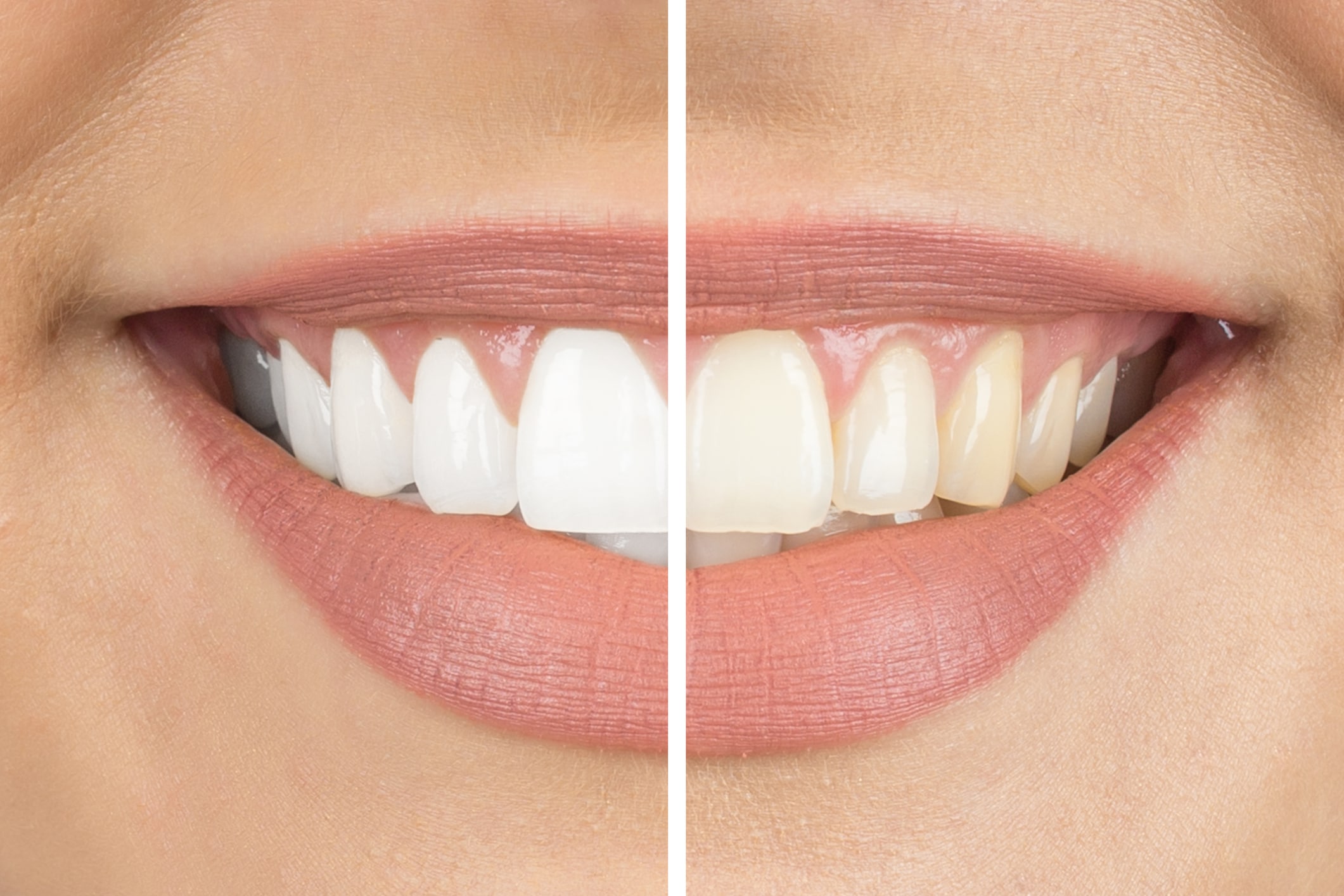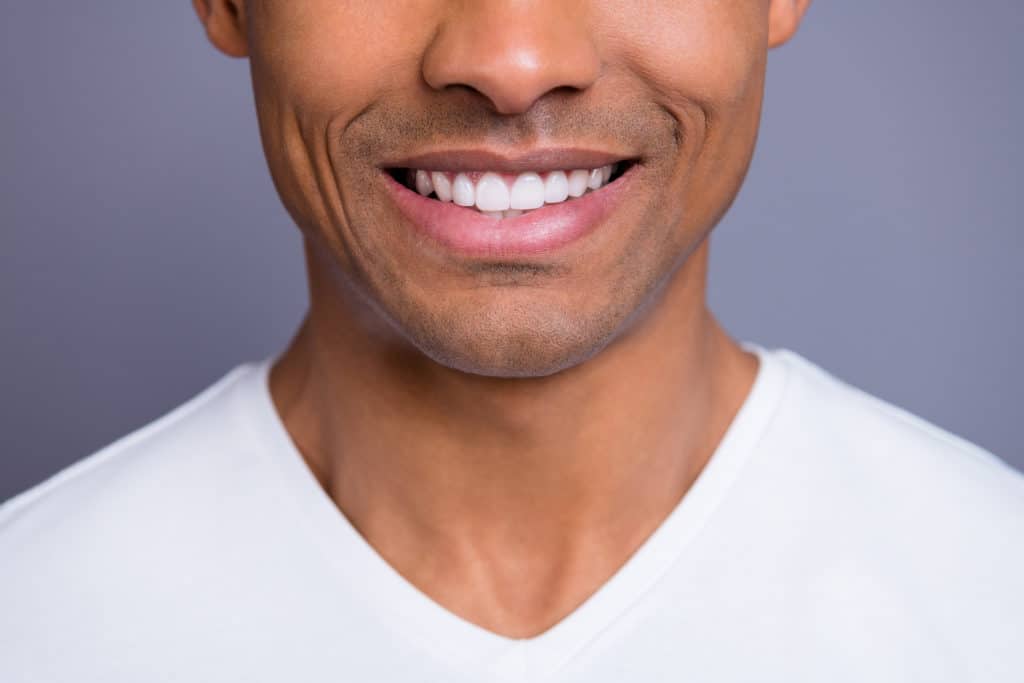Schmitt Dental offers teeth whitening in Clarksville, TN.
How Does Teeth Whitening Work?
Unless you have interior staining from tetracycline or tooth trauma, most teeth are stained in the enamel layer. This is because the enamel is somewhat porous, so drinking coffee or red wine or eating raspberries allows some of the color to enter the enamel. This isn’t unlike a shirt acquiring a stain. When we place the hydrogen peroxide gel onto your teeth, it acts in a similar way to laundry detergent. It also penetrates the enamel and breaks up the stain into tiny pieces that are washed away.
Who is an ideal candidate for teeth whitening?
The question of whether or not this is right for you is a question of your individual staining. If your stains are in your enamel, as is the case for the vast majority of patients, you’re a perfect candidate for our whitening treatments to whiten your teeth in a number of shades.
But if your teeth are stained in the dentin layer, the layer beneath the enamel, that staining doesn’t respond to teeth whitening treatments (despite the false claims you may have seen elsewhere). The peroxide whitening agents cannot penetrate deeply enough to have any effect on this deep staining. Staining in the dentin is usually a result of a reaction to the administration of tetracycline when the patient was a child.

In the 60s, tetracycline debuted as a promising new antibiotic and was given for ear infections and the like. However, the new drug turned out to cause grey staining in children’s teeth. This was a reaction caused only when the teeth were still developing. These stains are in the dentin layer, and they show through the outer enamel, which is translucent.
The only way to address dentin staining is to place porcelain veneers over the front surfaces of all the visible teeth.
How is teeth whitening performed?
At Schmitt Dental, we offer both in-office and at-home whitening treatment options. Here’s how we do them. While both achieve a similar degree of whitening, the difference is time. Our in-office whitening takes about one hour. At-home whitening takes a couple of weeks.
- In-office whitening — Our in-office whitening begins with a cleaning of your teeth and gums. Next, we place a protective barrier over your gums, to avoid contact with the whitening agent. Then we paint the hydrogen peroxide whitening gel onto your teeth. The gel is left on your teeth for five to 10 minutes and is then removed. This process is repeated three times. Our in-office whitening can whiten your teeth up to eight shades lighter in around one hour.
- At-home whitening — If you opt for in-home whitening, we begin by taking impressions of your teeth to use for the creation of customized whitening trays. These custom trays will ensure a tight, yet comfortable fit to maximize the contact between your teeth and the whitening gel. When your trays are ready, we provide you with syringes of carbamide peroxide gel (a much weaker strength than our in-office gel) and give you thorough instructions on the home whitening procedure. At home, you syringe the whitening gel into the bleaching trays and then fit the trays onto your teeth. The custom trays keep the gel on your teeth and prevent it from leaking onto your gums. You wear the trays for 30 minutes to one hour every day for one to two weeks.
How Long Does Teeth Whitening Last?
Once your whitening is complete, your teeth will be several shades whiter, but whitening is not permanent. Just as you stained them before, you can stain them again. This varies completely by the person, what they eat and drink, how porous their individual tooth enamel is, and how diligent their home hygiene program is.
How Many Teeth Whitening Treatments Are Needed?
At Schmitt Dental, many of our patients opt to have in-office whitening once a year. But, we can also create custom trays and provide gel to use at home to extend your whitening results. Or, if you don’t want the fuss, you simply return to our Clarksville offices and have another in-office treatment.
Benefits Of Teeth Whitening In-Office Over Take Home Kits
There are a couple of advantages to our in-office whitening versus our take-home whitening kits. First, it’s quick. At Schmitt Dental, our in-office whitening takes about one hour, and your teeth will be whitened up to eight shades. Second, since we apply the whitening gel, we ensure your lips and gums don’t come in contact with the hydrogen peroxide gel.

This keeps you comfortable. Sometimes, if a tray is overfilled at home, the whitening agent can come in contact with the gums, causing irritation.
What People Say About Us!
I’m usually nervous about going to the dentist, but the entire staff was very friendly. Laci made me totally at ease, and the dentist was gentle, thorough, and explained everything so I could understand it. A totally comfortable experience. I’ll be much more relaxed for my next appointment. Great staff.
Click here to read more reviews.
How Long Does In-Office Whitening Take?
At Schmitt Dental our in-office whitening takes about one hour, and your teeth are brightened up to eight shades. If you opt to have our home-whitening program, most patients need to wear their custom-made trays about 30 minutes a day for two weeks.
Is There Recovery After Teeth Whitening?
There isn’t any recovery or downtime after either in-office or at-home whitening. These treatments only affect the enamel layer of the teeth. As mentioned above, they can make the teeth somewhat more sensitive to hot and cold, but this only lasts a day or so.
Will Teeth Whitening Make My Teeth Sensitive?
Teeth whitening has been studied and performed around the world for over 20 years now and has proven to be very safe. Because the whitening agents penetrate the enamel of your teeth, your teeth can be a little sensitive to hot and cold foods and drinks for a brief period of time, but this passes quickly in a day or two. Still, if you have particularly sensitive teeth, be sure to tell us as we can desensitize your teeth with potassium nitrate or calcium phosphate before we perform the whitening.

Can Teeth Whitening Damage Your Teeth?
Teeth whitening is the most popular cosmetic dentistry procedure performed around the world, and it has proven to be absolutely safe. There have not been any instances in the U.S. of structural damage caused by approved whitening methods. Whether you opt for our in-office or at-home whitening options at Schmitt Dental you can be assured that your teeth will not be damaged in any way. They may be a little sensitive to hot and cold for a day or so, but this sensation quickly passes. There are no side effects.
Is teeth whitening safe for my teeth?
The American Dental Association has done numerous studies on teeth whitening, covering decades of procedures, and has concluded that teeth whitening is safe and has given its approval to various products (including what we use at Schmitt Dental). There are no recorded instances of irreversible or structural damage caused by whitening programs. Teeth whitening is popular all around the world and is performed millions of times every year without incident.
Is teeth whitening painful?
Teeth whitening is painless, whether you come into one of our three Schmitt Dental locations for in-office whitening or opt for custom trays and at-home whitening. When we perform in-office whitening, we cover your gums to ensure they don’t get the whitening gel on them. Your at-home custom trays only cover your teeth.
As mentioned above, your teeth can be a little more sensitive to hot and cold for a few days after your whitening treatment, but this isn’t “pain.”
How Tooth Discoloration Occurs
Teeth become stained either in the enamel layer or deeper in the dentin layer. Staining from foods and the like affects the enamel, the outer protective layer of the tooth. Those stains respond very well to whitening treatments. Unfortunately, other stains, particularly if caused by reactions to medications, can be in the dentin, which makes up the bulk of the tooth mass beneath the enamel. If those stains are too deep they may only be improved through the use of porcelain veneers or dental bonding.
What Stains Teeth The Most?
These are the different factors that can stain your teeth:
- Foods — Blackberries, blueberries, and raspberries all have natural pigments in them that stain your enamel.
- Drinks — Coffee, tea, red wine, some fruit juices, and even colas can all stain your teeth, especially if you drink a lot of them.

- Genes — The color of the enamel on our teeth is different, along with the dentin beneath (which can influence the outer color). Some teeth are simply more yellow than others.
- Smoking — Nicotine in cigarettes leaves yellow stains on your teeth.
- Drugs — Tetracycline is the main culprit in stained teeth. Heavily used as an antibiotic in the 60s and 70s, it deeply stained the teeth of many children.
- Fluorosis — There can be too much of a good thing when it comes to fluoride. Too much leads to fluorosis, which stains the teeth. This is rare.
How much does teeth whitening cost?
The cost of your teeth whitening treatments at Schmitt Dental varies depending on what you opt to have done. You can choose to have in-office whitening that takes about an hour or you can do the whitening at home. You may want to add extra gel for a combination of in-office followed by at-home long-term maintenance.
Once we know how you want to proceed, we will give you an exact price for your treatments.
Does Insurance Cover Teeth Whitening?
Teeth whitening is considered an elective procedure, so it is not covered by dental insurance plans. You can, however, pay for it out of your health savings plan.
